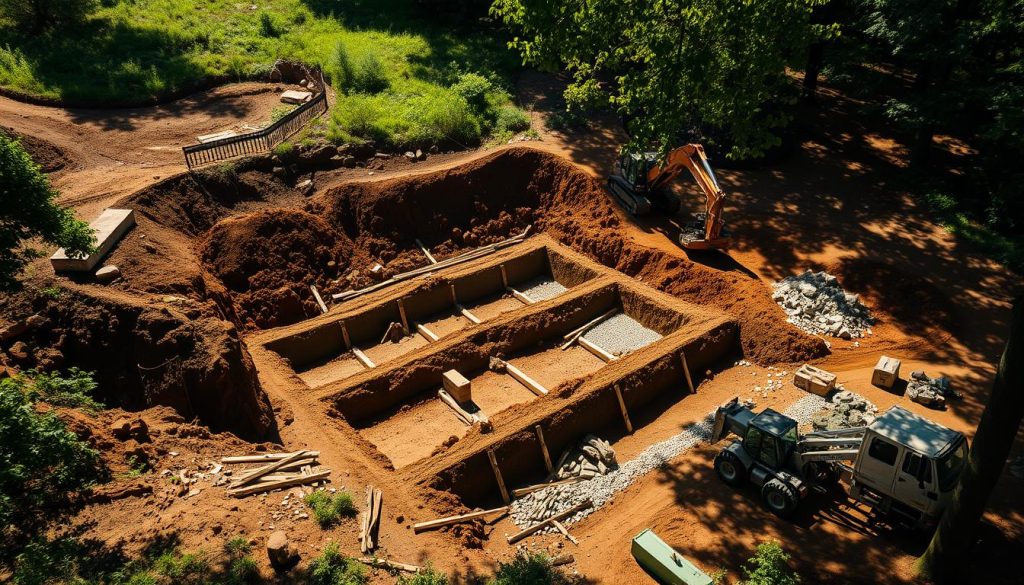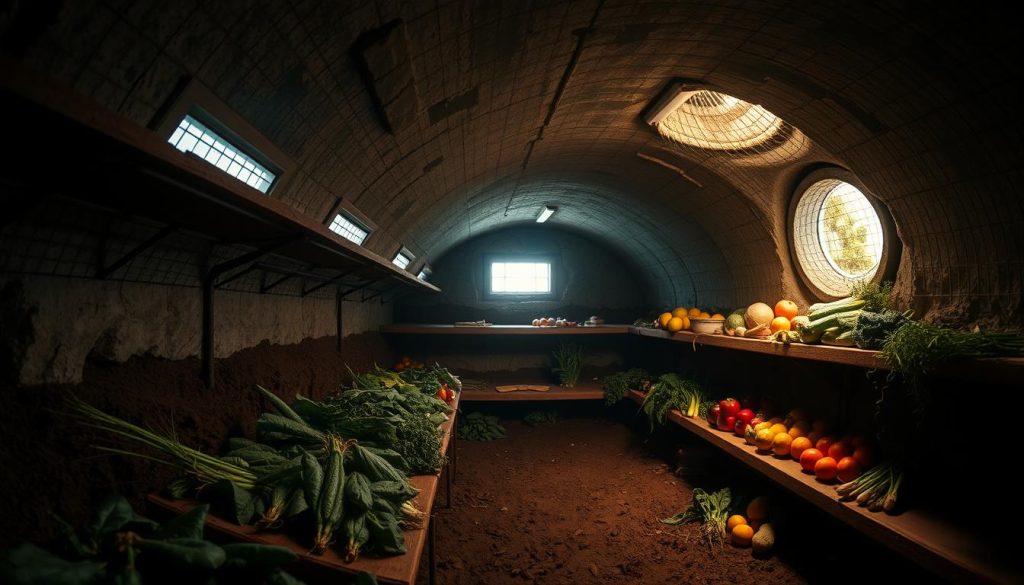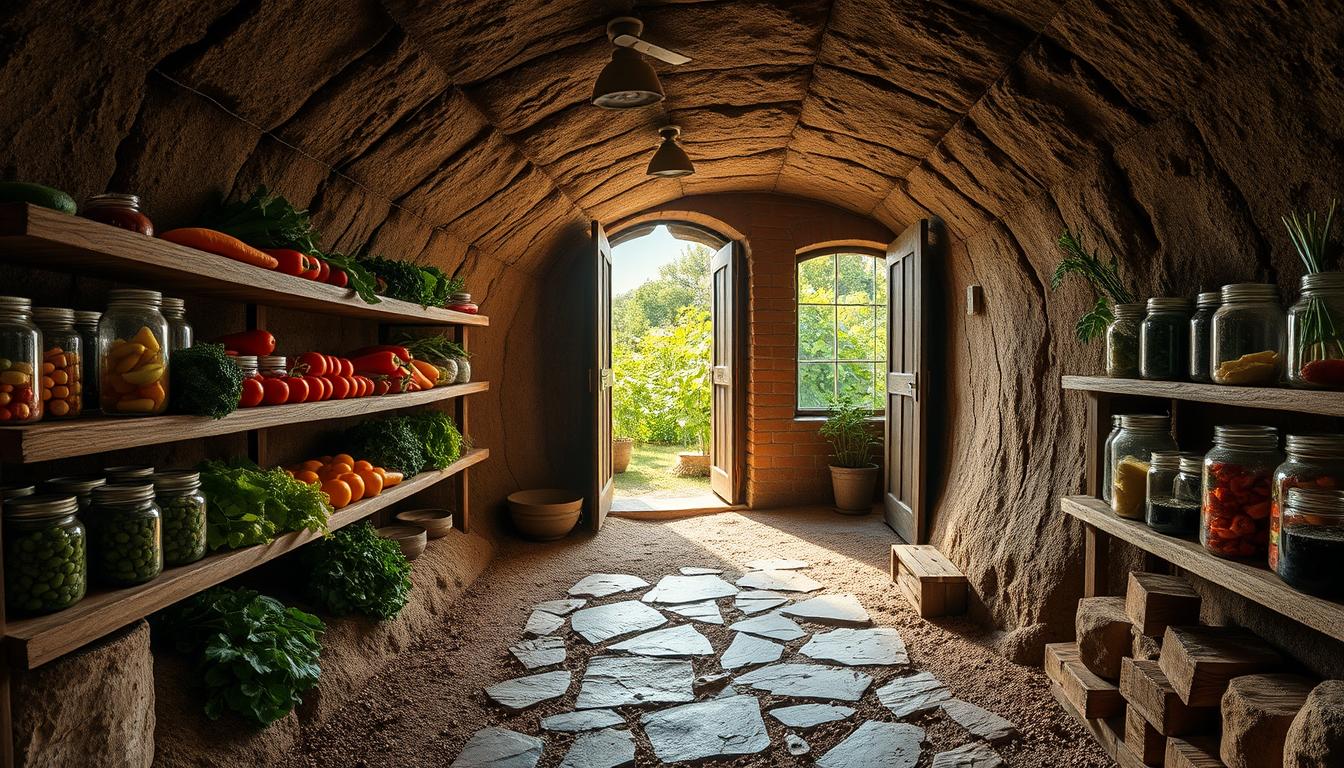A passive cooling root cellar is great for keeping food fresh. It uses the earth’s natural temperature to cool the cellar. This keeps your produce fresh for longer. Let’s dive into how to build one and make it efficient.
Building a root cellar is good for the planet and your food. It uses natural cooling, so you don’t need to use a lot of energy. We’ll cover the basics of building a root cellar that’s good for the environment.
What is a Passive Cooling Root Cellar?
A passive cooling root cellar is an underground space that uses the earth’s constant temperature for cooling. It’s a smart way to store food without needing electricity.
Definition and Purpose
The main goal of a passive cooling root cellar is to keep food cool all year. It uses the earth’s stable temperature for cooling. This makes it energy-efficient and eco-friendly.
Benefits of a Root Cellar
Root cellars have many advantages. They save energy by not needing electricity for cooling. They also keep food fresh longer. Plus, they’re good for the environment, helping to reduce carbon emissions.
Common Uses
People often use root cellars for underground food storage from their gardens. They’re also great for keeping food safe during power outages. And, they’re perfect for fermenting foods like wine or sauerkraut, where steady temperatures are key.
Key Principles of Passive Cooling
Understanding and applying the key principles of passive cooling is vital for designing a root cellar. These principles use the earth’s natural properties to create a stable and efficient space. This space is perfect for storing produce and other perishable items.
Natural Temperature Regulation
One key principle is using the earth’s geothermal properties to keep a stable temperature. The earth acts as a natural insulator. It keeps the root cellar cool in summer and warm in winter.
This natural temperature control greatly reduces the need for artificial cooling. It makes the system very energy-efficient.
Soil Insulation Benefits
The insulating properties of soil are key in maintaining the root cellar’s environment. Soil acts as a thermal barrier, keeping temperatures stable. This stability ensures the quality of stored items stays good for a long time.
Thermal Inertia
Thermal inertia is crucial for passive cooling’s success. It helps the storage environment resist sudden temperature changes. This resistance protects against extreme weather.
The combination of thermal inertia, geothermal properties, and soil insulation makes cooling reliable. It keeps your root cellar consistently cool.
Selecting the Right Location
Choosing the right spot for your root cellar is key. The location affects how well your cellar works and lasts. You need to think about elevation, drainage, sunlight, and wind to cool it naturally.
Ideal Site Characteristics
The perfect spot for a root cellar has a few must-haves. It should be high enough to avoid floods but not so high it’s hard to dig. Good drainage is vital to keep water away and prevent mold.
The spot should also be close to the water table but not too wet. This balance is crucial for keeping your cellar dry.
Sunlight and Wind Considerations
When picking a spot, think about sunlight and wind. A north-facing entrance keeps the temperature cool. Wind can help cool your cellar by bringing in fresh air.
Keep sunlight away to keep the inside cool and steady. This careful planning makes your root cellar efficient and reliable all year.
Planning Your Root Cellar Design
When planning your root cellar design, it’s crucial to approach it with comprehensive storage capacity planning in mind. This ensures that your root cellar is both efficient and capable of meeting your needs.
Size and Capacity Considerations
Your root cellar blueprint should be tailored to your specific requirements. I always begin by estimating the total volume of produce I plan to store. The size needed can vary greatly, depending on whether you’re a small-scale gardener or managing a large homestead. It’s also essential to consider future needs, allowing room for growth in your root cellar design.
Layout Options
Creating an effective layout is pivotal for maximizing space. I prefer using a mix of shelving, bins, and compartments to keep everything organized. Various layout options can significantly enhance the functionality of your root cellar:
- Shelving units for easy access to root vegetables.
- Bins for bulkier items like cabbages and squash.
- Compartments for separating different types of produce to maintain quality.
By meticulously planning your root cellar layout and incorporating elements such as durable shelves and stacking bins, you can ensure an efficient and well-organized storage system. Creating a custom root cellar design ultimately offers flexibility to tailor your space exactly as you want, making sure your root cellar is an asset for many years to come.
Essential Materials for Construction
Building a passive cooling root cellar needs the right materials. This ensures it’s both sustainable and efficient. We’ll look at the best materials and how to source them sustainably. This will help you make an eco-friendly and effective root cellar.
Recommended Building Materials
Picking the right materials is key for good insulation and temperature control. Here are some eco-friendly options to consider:
- Concrete: Its durability and thermal mass keep the temperature stable in the root cellar.
- Reclaimed Wood: It adds charm and supports sustainable construction by using old materials.
- Stone: Stone is great for insulation and is sustainable. Using local stones reduces transportation impacts.
- Insulated Panels: These panels are easy to use and control temperature well.
Sustainable Sourcing Tips
Sustainable construction means finding materials that are kind to the environment. Here are some tips for doing so:
- Reclaimed Materials: Use materials like wood, bricks, and metal from old buildings. It reduces waste and saves resources.
- Local Suppliers: Buying from local suppliers cuts down on transportation emissions and supports the local economy.
- Certified Sources: Choose materials with certifications like FSC for wood. It ensures they were harvested and made sustainably.
- Natural Insulation: Use eco-friendly insulations like sheep’s wool, hemp, or cellulose. They insulate well and are biodegradable.
By choosing the right materials and focusing on sustainability, you can build an efficient and green root cellar.
Excavation and Construction Steps

Building a root cellar needs careful planning in excavation and foundation. I’ll share some effective techniques for digging and laying a strong foundation.
Digging Techniques
Excavation depends on the soil and landscape. Sandy soils might need extra support to avoid cave-ins. Clay soils should have drainage to prevent water buildup.
- Manual Excavation: Great for small cellars and precise work. Use shovels and spades for control.
- Mechanical Excavation: Best for big projects. Backhoes and excavators speed up digging. Remember to mark utility lines and check local rules.
- Trenching Techniques: Good for drainage channels. Dig narrow trenches around the cellar.
Foundation Tips
The foundation is key for a root cellar’s durability. Focus on waterproofing and weight distribution to avoid problems.
- Waterproofing: Use rubberized coatings, plastic sheets, or waterproof concrete to keep walls and floors dry.
- Weight Distribution: Design the foundation to spread weight evenly. This keeps it stable. Reinforce with rebar for extra strength.
- Base Layer: Start with a gravel base for drainage and stability. A compacted gravel layer prevents shifting and settling.
Effective digging and solid foundation work make your root cellar a reliable storage solution for years.
Insulation Strategies for Efficiency
To keep your root cellar at the right temperature, it’s important to know about insulation types and how to install them. The right insulation can make your root cellar work better.
Types of Insulation
There are natural and synthetic insulation options for root cellars:
- Natural Insulation: This includes materials like cellulose, cork, and sheep’s wool. They are good for the environment and popular.
- Synthetic Insulation: Polystyrene and polyurethane are synthetic choices. They have high R-values, helping with better insulation and temperature control.
Proper Installation Techniques
Installing insulation correctly is crucial for your root cellar’s efficiency. Here are some tips:
- Avoid Thermal Bridging: Use continuous insulation layers to stop heat from getting through and into the cellar.
- Seal Gaps: Seal any gaps or cracks in the insulation to keep it tight and prevent airflow.
- Install Vapor Barriers: In humid areas, add a vapor barrier to stop moisture buildup, which can harm insulation.
By using these installation tips, your root cellar will keep a stable temperature. This protects your stored items all year round.
Ventilation: Keeping Airflow Optimal

A well-ventilated root cellar is key for keeping your stored produce fresh. Good ventilation helps control temperature and removes ethylene gas, which speeds up ripening and decay. To get the best airflow, you need to design the ventilation system right and control humidity well.
Designing Ventilation Systems
When setting up ventilation, it’s important to balance air coming in and going out. Root cellars usually have two vents. One is near the ceiling for warm air to escape, and the other is near the floor for cooler air to enter. This setup helps keep the temperature right and keeps your stored items fresh.
Using adjustable vents lets you adjust the ventilation as the seasons change. Adding a screen to the vents keeps pests out while keeping airflow free.
Managing Humidity Levels
Keeping the right humidity is also crucial in a root cellar. Too much moisture can cause mold and spoilage, while too little can dry out your produce. Aim for a humidity level of 85-95% to keep your food in top shape.
There are ways to manage humidity. For example, using gravel flooring and misting it now and then can keep humidity right. You can also place trays of water inside to add moisture when it’s dry. If it’s too humid, a dehumidifier can help lower the moisture levels.
Good ventilation and humidity control are the basics for a successful root cellar. They help make sure your preservation efforts pay off.
Cooling Techniques Beyond Passive Design
Traditional passive design is key for root cellars. But adding more cooling methods can make them even better. Using earth tubes and water features can improve cooling systems and root cellar designs.
Using Earth Tubes
Earth tubes are great for cooling. They use the cool underground air to cool the cellar. This method keeps the air inside cool and stable.
When set up right, earth tubes draw in cool air. They then cool it down even more before it gets to the cellar. This helps keep the stored food fresh.
Water Features for Additional Cooling
Water features can also cool your root cellar. Water keeps temperature better than air. This makes it a great cooling tool.
Small water features like underground cisterns or cool walls help control temperature. They work well with earth tubes to cool the cellar evenly. This makes for a smart and effective cooling system.
Maintaining a Root Cellar

To keep your root cellar working well, you need to check it often and make seasonal changes. Let’s look at the key steps for keeping your root cellar in good shape.
Regular Inspections and Upkeep
Checking your root cellar regularly is very important. Look for mold, pests, and any damage to the structure. Check the ceiling, walls, and floor for cracks or damage.
Mold grows in damp, airless places. So, it’s crucial to watch out for it. Regular checks help you catch problems early and fix them fast.
Another important thing is to keep pests away. Look for signs of rodents and insects that might harm your food. Sealing holes and keeping it clean can help a lot.
Seasonal Adjustments
Changing with the seasons is key to a good root cellar. In cold months, keep the temperature above freezing to protect your food. You might need more insulation or heat-retaining materials.
In warmer months, you need to cool it down. This keeps the temperature stable. Use fans or dehumidifiers to control humidity and temperature.
By following these steps, you can keep your food fresh and your root cellar in great shape all year.
Common Mistakes to Avoid
Building and keeping a root cellar needs careful attention. It’s important to watch out for mistakes in design, construction, and upkeep. Knowing these common errors can help make your cellar more efficient and last longer.
Design and Construction Pitfalls
Mistakes often happen during design and building. Some common construction mistakes include:
- Inadequate ventilation, leading to poor airflow and increased humidity.
- Incorrect insulation, which can result in temperature fluctuations.
- Neglecting waterproofing measures, causing unwanted moisture and mold growth.
It’s key to plan well and think about all design aspects to avoid these problems. Good insulation and ventilation are essential for a stable root cellar environment.
Maintenance Oversights
Even the best root cellars can face maintenance mistakes. Following maintenance best practices is crucial for optimal function. Common maintenance errors include:
- Skipping regular inspections, which can allow minor issues to escalate.
- Failing to adjust seasonal settings, such as temperature and humidity controls.
- Overlooking the cleaning schedule, leading to an unhealthy storage environment.
Keeping up with a strict upkeep routine helps avoid problems. This ensures your root cellar stays in top shape for storing food.
Expanding the Functionality of Your Root Cellar
A root cellar is great for storing fruits and veggies. But it can do even more. You can use it for many things, making the most of the space.
Additional Storage Ideas
Don’t just store fruits and veggies in your root cellar. You can also keep wine here. The cool, stable air is perfect for wine. It’s also great for canned goods and preserves, keeping them fresh longer.
Integrating with Gardening Plans
Make your gardening better by linking it to your root cellar. Plan your garden so you can easily move food to the cellar. This makes your farm-to-table process smoother and saves time.
Planting root crops like carrots and potatoes near your cellar makes things easier. This way, you can harvest and store food more efficiently. It turns your root cellar into a key part of your homestead. This approach makes your gardening and storage work together better.

